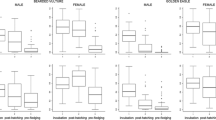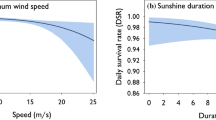Summary
Juveniles and immature birds normally have less foraging ability and a lower food intake rate than adults. This — it has been presumed — is compensated for by parental care and investment during juvenile development. Studies of time budgets and parental investment of Common Cranes were carried out in the years 1995 to 1999 in Northeast Germany. Having first marked young Cranes (colour rings, radio transmitters), we analysed the behaviour of parents and offspring to correlate this with reproductive success. Parents with young (39.6%) were four times more vigilant than non-breeders. The investment of pairs with two young was significantly (p<0.001) higher than in pairs with only one young. Females profited from the high vigilance rate of their males (males mean 43.9%, females 35.3%) and were thus able probably to compensate for their investment in the clutch faster because of higher food intake. Defence of the territory against other cranes and defence against predators were tasks mostly undertaken by males. If the males participated in the rearing of the young, the pair were able to rear two juveniles to fleding.
The young profited from parental care. They were able to feed most of the time (67.7%) with lower vigilance costs (11.9%; 27.7% less than parents), and thus possibly compensated for their lower feeding success. Rearing of two young, however, must be the upper limit of possible investment of adults. So far there has been no evidence of families with three grown-up young in a stopover region or on the wintering grounds. The survival of juveniles from the date of ringing in June up to the migration to the wintering sites in mid-November amounts to 77.9%, with 84% for families with one young and 75% for those with two young. Accordingly the reproductive success was higher for pairs with two young (1.32 juv./pair) than with one young (0.84 juv/pair).
The long-term survival of the population in a man-made landscape is only possible with an appropriate reproductive success. The offspring of crane families have to feed throughout the major part of the day in order to gain their energy for the high metabolic rate during growth. With a negative energy balance because of too much disturbance, the reproductive success will decrease. Future landscape planning should avoid new traffic structures, buildings (e.g. wind turbines) or power lines at least in areas of high crane density.
Zusammenfassung
Junge Graukraniche haben einen weniger guten Jagderfolg bzw. eine geringere Rate bei der Nahrungsaufnahme als Altvögel. Dieses Defizit sollte durch die elterliche Investition bei der Jungenaufzucht kompensiert werden. Untersuchungen zum Zeitbudget und zum Aufwand aus dem Brutgebiet fehlen bisher. Mit Hilfe markierter Jungkraniche (Farbringe, Sender) wurde das Verhalten der Eltern und ihrer Nachkommen erfasst, um die Investitionen in Beziehung zum Reproduktionserfolg zu analysieren. Die Eltern sicherten mit 39,6% fast viermal so häufig wie Altvögel ohne Junge (Übersommerer). Bei Paaren mit zwei Nachkommen waren diese Aufwendungen höher als bei Paaren mit nur einem Jungvogel. Das Weibchen profitierte vom verstärkten Sichern des Männchens (Männchen: durchschnittlich 43,9%, Weibchen 35,3%) und konnte so vermutlich schneller seine Investition in die Gelegeproduktion ausgleichen. Die Revierverteidigung bzw. Feindabwehr übernahmen meist die Männchen. Die Beteiligung des Männchens förderte den Aufzuchterfolg, der auf zwei Junge begrenzt ist. Die Jungen profitierten von den Leistungen ihrer Eltern. Sie konnten mit geringem Sicherungsaufwand (11,9%) Nahrung suchen (67,7%, Eltern 42,8%) und so ihre geringere Aufnahmerate kompensieren. 77,9% der Jungkraniche überlebten vom Zeitpunkt des Markierens im Juni bis zum Abzug ins Überwinterungsgebiet im Oktober/November (84% der Einzeljungen und 75% bei Familien mit zwei Nachkommen).
Junge Kraniche müssen einen wesentlichen Teil des Tages Nahrung aufnehmen, um den Energiebedarf für ein schnelles Wachstum sicherzustellen. Bei einer negativen Energiebilanz aufgrund zu vieler Störreize können die Erfolge bei der Jungenaufzucht sinken. Im Rahmen der Landschaftsplanung ist vor allem in Räumen mit einer hohen Siedlungsdichte des Kranichs auf eine stärkere Bebauung (z. B. mit Windkraftanlagen) oder Zerschneidung durch weitere Verkehrswege und Energieleitungen zu verzichten.
Similar content being viewed by others
Literatur
Alonso, J.A. & Alonso, J.C. (1993): Age-related differences in time budgets and parental care in wintering Common Cranes. Auk 110: 77–88.
Alonso, J.A. & Alonso, J.C. (1999): Colour marking of Common Cranes in Europe: first results from the European data base. Vogelwelt 120: 295–300.
Alonso, J.A., Veiga, J.P. & Alonso, J.C. (1986): Time Budgeting and social structure of Common CranesGrus grus wintering in Iberia. Ricerche di Biologia della Selvaggina (10), Bologna: 1–14.
Alonso, J.C., Veiga, J.P. & Alonso, J.A. (1984): Familienauflösung und Abzug aus dem Winterquartier beim KranichGrus grus. J. Ornithol. 125: 69–74.
Altmann, J. (1974): Observational study of behaviour: sampling methods. Behaviour 49: 227–267.
Archibald, G. W. (1975): The evolutionary and taxonomic relationship of cranes as revealed by their unison call. Ph.D. Thesis Cornell Univ., Ithaca, N. Y.
Begon, M.E., Harper, J.L. & Townsend, C.R. (1998): Ökologie. Heidelberg.
Bortz, J., Lienert, G. A. & Boehnke, K. (1990): Verteilungsfreie Methoden in der Biostatistik. Berlin.
Bried, J. & Jouventin, P. (1999): Influence of breeding success on fidelity in long-lived birds: an experimental study. J. Avian Biol. 30: 392–398.
Burger, J. (1987): Foraging efficiency in gulls: A comparison of age differences in efficiency and age of maturity. In: Hand, J.L., Southern, W.E. & Vermeer, K. (Eds.): Ecology and behaviour of gulls. Stud. Avian Biol. 10: 83–90.
Clutton-Brock, T.H. (1988): Reproductive Success. In: Clutton-Brock, T.H. (Ed.): Reproductive Success: 472–485. Chicago.
Clutton-Brock, T.H. (1991): The Evolution of Parental Care. Princeton, New Jersey.
Dittami, J. P. (1981): Seasonal changes in the behavior and plasma titers of various hormones in barheaded geese,Anser indicus. Z. Tierpsychol 55: 289–324.
Draulans, D. (1987): The effect of prey density on foraging behaviour and success of adult and first-year Grey Herons (Ardea cinerea) in winter. J. Anim. Ecol. 54: 771–780.
Egushi, K., Nagata, H., Takeish, M., Henmi, Y. & Takatsuka, M. (1987): Foraging and time budget of the Hooded Cranes in a wintering area at Yashiro, Japan. In: Lewis, J.C. (Ed.): Proc. 1987 Int. Crane Workshop: 305–310 Grand Island, Nebraska.
Fichtner, T. (1997): Untersuchungen über Verhalten und Habitatnutzung übersommernder Kraniche (Grus grus) in Westmecklenburg. Diplomarbeit Fachhochschule Nürtingen.
Fox, A.D. (1995): Diurnal activity budgets of prenesting Sandhill Cranes in arctic Canada. Wilson Bull. 107: 752–756.
Glutz von Blotzheim, U. N., Bauer, K. M. & Bezzel, E. (1973): Handbuch der Vögel Mitteleuropas. Bd. 5. Frankfurt am Main.
Golet, G. H., Irons, D. B. & Estes, J. A. (1998): Survival costs of chick rearing in black-legged kittiwakes. J. Anim. Ecol. 67: 827–841.
Goss-Custard, J. D. & dit Durell, S.E.A. le V. (1987): Age-related effects in OystercatchersHaematopus ostralegus, feeding on musselsMytilus edulis. II. Aggression. J. Anim. Ecol. 56: 537–548.
Greig-Smith, P.W. (1985): Winter survival, home ranges and feeding of first year and adult Bullfinches. In: Sibly, R.M. & Smith, R.H. (Eds.): Behavioural ecology: Oxford: 387–392.
Hartup, B. K. & Horwich, R. H. (1994): Early Parental Care and Chick Development in a Cross-Fostering With White-Naped (Grus vipio) and Greater Sandhill (Grus canadensis tabida) Cranes. Bird Behav. 10: 21–27.
Immelmann, K. (1983): Einführung in die Verhaltensforschung. Berlin.
Lamprecht, J. (1986): Structure and causation of the dominance hierarchy in a flock of bar-headed geese (Anser indicus). Behaviour 96: 28–48.
Lazarus, J. & Inglis, I. R. (1978): The breeding behaviour of the Pink-footed Goose: parental care and vigilant behaviour during the fledging period. Behaviour 65: 62–88.
Littlefield, C.D. (1995a): An unusual record of Sandhill Crane philopatry. Wilson Bull. 107: 766.
Littlefield, C. D. (1995b): Demographics of a declining Flock of Greater Sandhill Cranes in Oregon. Wilson Bull. 107: 667–674.
Loonen; M.J.J.E., (1997): Goose breeding ecology: overcoming successive hurdles to raise goslings. PhD thesis Univ. Groningen.
Loonen, M.J.J.E., Bruinzeel, L. W., Black, J.M. & Drent, R.H. (1997): The benefit of large broods in Barnacle Geese: a study using natural and experimental manipulations. In: Loonen, M.J.J.E. (Ed.): Goose breeding ecology: 111–135. Dissertation Universität Groningen.
Masatomi, H. & Kitagawa, T. (1975): Bionomics and Sociology of Tancho or the Japanese Crane,Grus japonensis, II. Ethogramm. J. Faculty Science, Hokkaido Univ., Series 6, 19: 834–878.
Mewes, W. (1995): Die Bestandsentwicklung des KranichsGrus grus in Deutschland und deren Ursachen. Dissertation Univ. Halle-Wittenberg.
Mewes, W. (1996): Bestandsentwicklung, Verbreitung und Siedlungsdichte des Kranichs in Deutschland. Vogelwelt 117: 103–109.
Mills, J. A. (1979): Factors affecting the egg size of Red-billed GullsLarus novaehollandiae scopulinus. Ibis 121: 53–67.
Nowald, G. (1995): Rückzugsgebiete? — Die Bedeutung von Schutzgebieten für den KranichGrus grus in Mecklenburg-Vorpommern. Naturschutzarb. Mecklenburg-Vorp. 38: 19–25.
Nowald, G. (1997): Untersuchungen zum Sammelund Rastplatzverhalten des Kranichs im Rahmen des BMFT-Verbundprojektes „Auswirkungen und Funktion unzerschnittener störungsarmer Landschaftsräume für Wirbeltierarten mit großen Raumansprüchen“. Unveröff. Studie im Auftrag der Gesellschaft für Naturschutz und Landschaftsökologie e. V., Kratzeburg.
Nowald, G. (1999a). Reviergröße und Raumnutzung jungeführender KranicheGrus grus in Mecklenburg-Vorpommern: erste Ergebnisse einer Telemetriestudie. Vogelwelt 120: 261–274.
Nowald, G. (1999b): Nahrungsbedarf rastender KranicheGrus grus während der Frühjahrsrast. In: Prange, H., Nowald, G. & Mewes, W. (Eds.): Proceedings 3rd European Crane Workshop: 115–122. Halle-Wittenberg.
Nowald, G. (im Druck): Effects of food availability and disturbances on habitat use and selection in the breeding territories of crane families (Grus grus): preliminary results of a radio-tracking study. Proceedings 4th European Crane Workshop, Verdun.
Nowald, G. & Mewes, W. (1996): Trompetenrufe übers Land. Die „Langenhägener Seewiesen“: Treffpunkt für Kraniche. Falke 43: 264–267.
Nowald, G., Mewes, W., Alonso, J. C. & Alonso, J. A. (1996): Farbmarkierung von KranichenGrus grus in Deutschland — ein Zwischenbericht. Vogelwelt 117: 119–124.
Nowald, G., Mewes, W. & Prange, H. (1998): Arbeitsgemeinschaft „Kranichschutz Deutschland“: Brutplätze und Rastgebiete für den Kranich. Falke 45: 16–17.
Ollason, J. C. & Dunnet, G. M. (1988): Variation in Breeding Success in Fulmars. In: Clutton-Brock, T. H. (Ed.): Reproductive Success: 263–278. Chicago.
Owen, M., Black, J. M. & Liber, H. (1987): Pair bond duration and timing of its formation in barnacle geese (Branta leucopsis). In: Weller, M. (Ed.): Waterfowl in winter: 23–28. Minneapolis.
Owen, M. & Black, J. M. (1989a): Barnacle Goose. In: Newton, I. (Ed.): Lifetime Reproduction in Birds: 349–362. London.
Owen, M. & Black, J. M. (1989b): Factors affecting the survival of Barnacle Geese on migration from the breeding grounds. J. Anim. Ecol. 58: 603–617.
Partridge, L. (1989): Liftetime Reproductive Success and Life-history Evolution. In: Newton, I. (Ed.): Liftetime Reproduction in Birds: 421–440. London.
Prange, H. (1989): Der Graue Kranich. Die Neue Brehm-Bücherei 229, Wittenberg Lutherstadt.
Raveling, D. G. (1979): The annual cycle of body composition of Canada Geese with special reference to control of reproduction. Auk 96: 234–252.
Schneider, J. & Lamprecht, J. (1990): The importance of biparental care in a precocial, monogamous bird, the bar-headed goose (Anser indicus). Behav. Ecol. Sociobiol. 27: 415–49.
Scott, D. K. (1988): Breeding Success in Bewick's Swans. In: Clutton-Brock, T. H. (Ed.): Reproductive Success: 220–236. Chicago.
Stearns, S. C. (1992): The evolution of life histories. Oxford.
Tacha, T. C. (1988): Social organization of Sandhill Cranes from midcontinental North America. Wildl. Monogr. 99: 1–37.
Thomson, S. C. & Raveling, D. G. (1987): Incubation behaviour of emperor geese compared with other geese: interactions of predation, body-size and energetics. Auk 104: 707–716.
Wilkening, B. (1999): Verhalten und Habitatwahl einer übersommernden Nichbrüter-Population des KranichsGrus grus in der Kulturlandschaft. In: Prange, H., Nowald, G. & Mewes, W. (Eds:): Proceedings 3rd European Crane Workshop: 58–63. Halle-Wittenberg.
Wooller, R. D., Bradley, J. S., Skira, I. J. & Serventy, D. L. (1989): Short-tailed Shearwater. In: Newton, I. (Ed.): Lifetime Reproduction in Birds: 405–417. London.
Wunderle, J.M. jr. (1991): Age-specific foraging proficiency in birds. In: Johnston, R. F. (Ed.): Current ornithology. Vol. 1: 273–324. New York.
Author information
Authors and Affiliations
Rights and permissions
About this article
Cite this article
Nowald, G. Verhalten von Kranichfamilien (Grus grus) in Brutrevieren Nordostdeutschlands: Investition der Altvögel in ihre Nachkommen. J Ornithol 142, 390–403 (2001). https://doi.org/10.1007/BF01651338
Accepted:
Published:
Issue Date:
DOI: https://doi.org/10.1007/BF01651338




